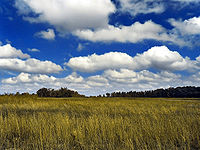
Photo from wikipedia
Cloud is an important factor that affects weather and climate, and the vertical distribution of cloud determines its role in the atmospheric radiation transfer process. In this paper, the characteristics… Click to show full abstract
Cloud is an important factor that affects weather and climate, and the vertical distribution of cloud determines its role in the atmospheric radiation transfer process. In this paper, the characteristics of different cloud types and their vertical cloud base height distributions over Eastern China are investigated with a four-year 2B-CLDCLASS-LIDAR product. The intercomparison of cloud base height distribution from ground-based lidar, CloudSat and CALIPSO measurements was studied with observations over the Hefei and Jinhua areas. The 2B-CLDCLASS-LIDAR product has the potential to uncover geographical and seasonal changes in cloud base height distribution over the Hefei area and Jinhua area, which may be beneficial for local climate models, although the CPR on CloudSat suffers from surface clutter or blind-zones. The results show that for non-precipitation cloud over the defined region (Eastern China), the occurrence frequencies of altocumulus, stratocumulus, and cirrus clouds are 29.4%, 21.0%, and 18.9%, respectively. The vertical occurrence frequencies of their cloud base heights are 0.5–8.5 km, below 3.5 km, and 5.5–17.0 km. The precipitation clouds are dominated by nimbostratus (48.4%), cumulus (17.9%), and deep convective clouds (24.2%), and their cloud base heights are all below 3.0 km. The cloud base height distributions have large differences below 3 km between the satellite measurement and ground-based measurement over Hefei site. Between the Hefei site and Jinhua site, the difference in cloud base height distribution measured by ground-based lidar is in good agreement with that measured by satellite over their matched grid boxes. Over the Hefei site, the vertical occurrence frequencies of cloud base height measured by ground-based lidar are higher than the satellite measurement within 0–0.5 km during all the seasons. It is suggested that more cloudy days may result from the sufficient water vapor environment in Hefei. In summer, the occurrence frequency of the cloud base height distribution at a height of 0–2.0 km is lower than other seasons over Jinhua city, which may be associated with the local weather system. Over the Jinhua site, the difference in seasonal cloud base height distribution based on satellite is in good agreement with that based on ground-based lidar. However, it does not appear over Hefei site. Thus, a multi-platform observation of cloud base height seems to be one of the essential ways for improvement in the observation of cloud macroscopic properties.
Journal Title: Atmosphere
Year Published: 2019
Link to full text (if available)
Share on Social Media: Sign Up to like & get
recommendations!